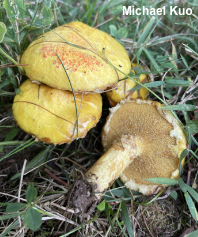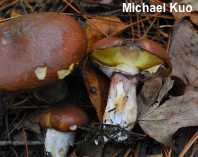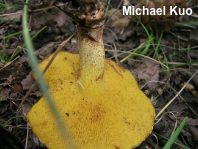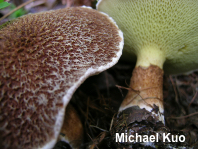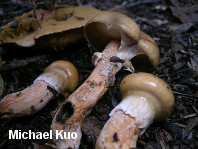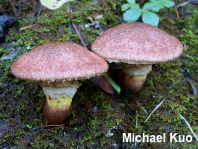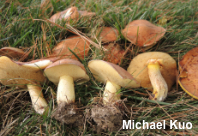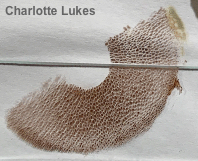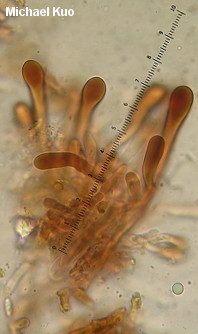Key to 51 Suillus and Suillus-like Species in North America 
| 1. | Associated with hardwoods. | 2 |
| 1. | Associated with conifers. | 5 |
| 2. | Associated with oaks in the Great Lakes region; with a yellowish partial veil that extends nearly to the ground when the mushroom is young; flesh and pore surface bruising strongly brown; spores round or nearly so. | |
| 2. | Variously distributed; partial veil absent or limited to a roll of tissue around the cap margin; bruising brown or not bruising; spores ellipsoid to boletoid-fusiform. | 3 |
| 3. | Found primarily under oaks; cap yellow or brown; young pore surface yellow; stem without glandular dots. | 4 |
| 4. | Cap and stem yellow; mature pores small, not radially arranged; stem not reticulate. | |
| 4. | Cap and stem brown; mature pores larger, angular, radially arranged; stem becoming widely reticulate near the apex. | |
| 5. | Associated with other conifers. | 14 |
| 6. | Associated with imported European larch (Larix decidua); cap yellow to orangish yellow when young, and usually remaining so or becoming brownish yellow at maturity; pileipellis lacking reddish brown pigment globules when mounted in KOH. | |
| 6. | Associated with native larches; morphology varying. | 7 |
| 7. | Associated primarily with western larch (Larix occidentalis) and found from the northern Rocky Mountains to the Pacific Northwest; cap pink to pinkish red; pore surface initially yellow. | Suillus ochraceoroseus |
| 7. | Associated primarily with tamarack (Larix laricina) and found from the northern Midwest eastward (some species occasionally reported from western North America, possibly erroneously); cap and pore surface varying. | 8 |
| 8. | Fresh, young pore surface whitish to grayish. | 9 |
| 8. | Young pore surface a shade of yellow. | 10 |
| 9. | Fresh cap sticky and brown to gray-grown or yellow-brown; sliced flesh sometimes bluing slightly. | Suillus elbensis
= "aeruginascens," "viscidus,"
serotinus, solidipes |
| 9. | Fresh cap moist or dry, whitish to olive buff; flesh not bluing. | Suillus grisellus |
| 10. | Cap often yellow at first but usually becoming reddish brown to brownish red with development; pores not boletinoid; stem with a collapsing, gelatinizing ring; pileipellis with abundant red pigment globules when mounted in KOH. | |
| 10. | Cap variously colored but never yellow; pores slightly to prominently boletinoid; ring variable; pileipellis without red pigment globules. | 11 |
| 11. | Cap brown to dark reddish brown. | 13 |
| 12. | Partial veil gelatinous and red; cap sticky, with grayish patches; pore surface only slightly boletinoid. | |
| 12. | Partial veil not red, not gelatinous; cap dry, with concolorous scales; pore surface prominently boletinoid—often almost appearing gilled and cross-veined. | Suillus paluster |
| 13. | Cap chocolate brown to yellow-brown, prominently fibrillose-scaly; stem dark brown below a yellow apex; flesh white to very pale yellow, usually developing a prominent cavity in the mature stem. | |
| 13. | Cap reddish brown to orangish brown, fairly bald; stem yellow to brownish overall; flesh yellow, not developing a cavity in the stem. | Suillus glandulosus
~ = sinuspaulianus |
| 14. | Associated with pines (species of Pinus, with bundled needles in groups of 2, 3, or 5). Note: Species of Suillus are reported to occur under spruces, firs, and hemlocks in North America—but these reports may be inaccurate, representing misidentification of the mycorrhizal host (especially once the "toppling distance" possibility discussed above is taken into consideration)—or some of the reports may be accurate; careful documentation is needed. | 18 |
| 15. | Partial veil absent; flesh never staining blue to green, even in stem base; mature stem with conspicuous glandular dots. | Suillus punctatipes |
| 15. | Partial veil present; flesh often staining blue to green, at least in stem base; stem without conspicuous glandular dots. | 16 |
| 16. | Distributed throughout western North America where Douglas-fir occurs; cap scaly and fairly dry when fresh. | |
| 16. | Distributed in the Pacific Northwest and California; cap bald or nearly so (sometimes slightly fibrillose in age), sticky to slimy when fresh. | 17 |
| 17. | Partial veil covered with yellow to orange gluten; ring gelatinous and tinged orange to cinnamon. | |
| 17. | Partial veil and ring dry and whitish. | |
| 18. | Associated with soft pines (with needles of varying lengths bundled in groups of 5). | 19 |
| 18. | Associated with hard pines (with needles of varying lengths bundled in groups of 2 or 3). | 33 |
| 19. | Found from the Rocky Mountains westward. | 20 |
| 19. | Found from the Great Plains eastward. | 25 |
| 20. | Fresh cap yellow to dull yellow, with scattered red fibrils. | |
| 20. | Fresh cap a shade of brown. | 21 |
| 21. | Flesh turning pale to dark blue when sliced (especially above the tubes and in the stem apex); flesh in stem usually orange; cap with brown fibrillose scales. | Suillus discolor |
| 21. | Flesh not bluing; flesh in stem not orange; cap usually smoother and more bald than above. | 22 |
| 22. | Partial veil or "false veil" absent—thus the cap margin is naked and without a roll of sterile tissue, even when young; limited to association with whitebark pine (Pinus albicaulis, found in the northern Rocky Mountains and the Sierra Nevada at high elevations). | Suillus subalpinus |
| 22. | Partial veil or false veil present—thus the cap margin has either a soft roll of sterile tissue or tattered veil remnants, at least when young; associated with various 5-needle pines. | 23 |
| 23. | Stem without glandular dots, or with only a few inconspicuous glandular dots near the apex in old age; poorly understood species often confused with Suillus pseudobrevipes (which associates with hard pines). | Suillus albivelatus |
| 23. | Glandular dots present and usually conspicuous by maturity. | 24 |
| 24. | Cap becoming dark brown to dark purplish brown with maturity (reminiscent of Suillus luteus); stem base often bruising or staining reddish brown. | Suillus brunnescens
= borealis |
| 24. | Cap becoming tan to cinnamon brown with maturity; stem base not bruising reddish brown. | Suillus glandulosipes
= alidipes, neoalbidipes |
| 25. | Cap white to off-white throughout development. | |
| 25. | Fresh cap more highly colored. | 26 |
| 26. | Fresh cap dry, pinkish red to brick red, and fibrillose-scaly. | |
| 26. | Cap sticky to slimy when fresh, not red, not scaly. | 27 |
| 27. | Mushroom with neither a partial veil nor a "false veil"; ring not present on stem, cap margin without veil remnants, and without a soft roll of sterile tissue (however, a tiny zone of whitish fuzz may be present on very young cap margins). | 28 |
| 27. | Partial veil or false veil present, resulting in a ring on the stem and/or remnants on the cap margin—or a soft roll of tissue on the cap margin. | 29 |
| 28. | Fresh cap a shade of brown (orange-brown, reddish brown, etc.); young pore surface yellow; KOH black to gray (sometimes with a preliminary green flash) on cap. | |
| 29. | Fresh cap dark brown, often appearing streaked under the gluten; stem with an ample, whitish ring that becomes purple to brown on the underside. | |
| 29. | Fresh cap yellow, yellow-brown, or tan, and usually not appearing streaked; ring absent or, if present, bracelet-like or minimal, and not developing a purple underside. | 30 |
| 30. | Cap with red fibrils or developing red to reddish discolorations. | 31 |
| 30. | Cap without red fibrils, not developing red stains. | 32 |
| 31. | Young pore surface pale orange to orange; ring never present. | |
| 31. | Young pore surface yellow; collapsed ring or ring zone sometimes present. | |
| 32. | Ring present, becoming bracelet-like and gelatinous; cap margin sometimes featuring tattered whitish veil remnants. | |
| 32. | Ring absent; cap margin with a "false veil" (a soft roll of sterile tissue). | Suillus glandulosipes
= albidipes, neoalbidipes |
| 33. | Found from the Rocky Mountains westward. | 34 |
| 33. | Found from the Great Plains eastward. | 52 |
| 34. | Partial veil or "false veil" present (check young specimens), observable as veil tatters on the cap margin, or as a soft roll of sterile tissue along the young cap margin, and/or as a ring or ring zone on the stem. (See also uncertain taxa, below.) | 35 |
| 34. | Partial veil or false veil absent in all stages of development. | 43 |
| 35. | Ring or ring zone absent, even in young specimens. | 36 |
| 35. | Ring or ring zone present. | 38 |
| 36. | Growing under Jeffrey pine (Pinus jeffreyi, with long needles in bundles of 3 and large, 9-inch cones) in the Sierra Nevada, in summer; stem without glandular dots. | Suillus volcanalis |
| 36. | Habitat, association, and season varying; with or without glandular dots on the stem. | 37 |
| 37. | Stem developing glandular dots by maturity; false veil (a soft roll of sterile tissue) present on cap margin, at least when young. | Suillus glandulosipes
= albidipes, neoalbidipes |
| 37. | Glandular dots absent or very inconspicuous at maturity; partial veil tatters present on cap margin. | Suillus albivelatus |
| 38. | Cap margin with veil remnants. | 39 |
| 38. | Cap margin wihtout veil remnants. | 40 |
| 39. | Lower half of stem sheathed with soft tissue that collapses to form a ring. | |
| 39. | Veil "leaving a poorly formed zone of squamules midway on the stipe" (Smith et al. 1965) rather than sheathing it. | Suillus albivelatus |
| 40. | Mature pores large (1 mm or more across). | 41 |
| 40. | Mature pores smaller than 1 mm across. | 42 |
| 41. | Pores with an irregular, almost malformed appearance (reminiscent of malformed "gills" in Macowanites); ring dry. | Suillus megaporinus |
| 41. | Pores more "normal looking"; fresh ring wet or partly gelatinized. | Suillus umbonatus |
| 42. | Cap dull yellow to brownish yellow; ring bracelet-like and gelatinized, whitish to grayish; presence in western North America debatable, not reliably documented. | |
| 42. | Cap brown to reddish brown, often radially streaked with darker pigments; ring large, whitish with lilac to purple shades; presence in western North America well documented. | |
| 43. | Mature pores large and elongated, or nearly gill-like. | 44 |
| 43. | Mature pores circular to angular, and not notably elongated. | 45 |
| 44. | Mature cap large (10 cm or more across); pores elongated; associated primarily with ponderosa pine (Pinus ponderosa, with needles 4–11 inches long in bundles of 2 and 3 and bark in large orangish plates). | Suillus anomalus |
| 44. | Mature cap small (2–5 cm across); pores nearly gill-like; associated with lodgepole pine (Pinus contorta, with needles 1–3 inches long in bundles of 2 and scaly bark). | Suillus helenae |
| 45. | Fresh cap relatively dry, velvety to scaly. | 46 |
| 45. | Fresh cap sticky to slimy, bald or, with maturity, slightly fibrillose or fibrillose scaly. | 47 |
| 46. | Flesh turning blue when sliced, at least over the tubes and in the stem; cap yellow to orangish yellow or orangish brown. | |
| 46. | Flesh not bluing when sliced; cap dark brown to brown. | Suillus fuscotomentosus |
| 47. | Glandular dots on stem absent or very inconspicuous throughout development; stature often squat, with the stem length shorter than the cap width. | |
| 47. | Glandular dots conspicuous—or, if inconspicuous when young, becoming prominent with age; stature varying. | 48 |
| 48. | Found in the Rocky Mountains under ponderosa pine (Pinus ponderosa, with needles 4–11 inches long in bundles of 2 and 3 and bark in large orangish plates). | 49 |
| 48. | Found on the West Coast under Monterey pine (Pinus radiata, with needles in bundles of 3) or bishop pine (Pinus muricata, with needles in bundles of 2). | 50 |
| 49. | Young pore surface orange, covered with abundant glandular dots; cap purple with KOH. | |
| 49. | Young pore surface yellow, without glandular dots; cap dark gray with KOH. | |
| 50. | Young cap whitish, becoming olive or gray before maturing to brown; odor often strong and fragrant or unpleasant; distributed primarily in the Bay Area. | |
| 50. | Young cap a shade of brown; odor not distinctive (or not recorded); distributed in the Bay Area or more widely in the Pacific Northwest. | 51 |
| 51. | Associated with Monterey pine (Pinus radiata, with needles in bundles of 3); glandular dots on stem becoming conspicuous by maturity; stem without a glutinous sheath. | Suillus acerbus |
| 51. | Associated with bishop pine (Pinus muricata, with needles in bundles of 2) and suspected with other 2-needle pines; glandular dots relatively inconspicuous throughout development; stem occasionally overlaid with a sheath of reddish brown gluten. | Suillus quiescens |
| 52. | Fresh cap relatively dry, conspicuously fibrillose to scaly. | 53 |
| 52. | Fresh cap sticky to slimy; bald or only slightly fibrillose. | 54 |
| 53. | Found in the northern Midwest; flesh usually staining blue when sliced, at least over the tubes and in the stem; mature pores 2–3 per mm, not conspicuously radially arranged. | |
| 54. | Found from roughly New Jersey to Texas and Mexico; flesh not bluing; mature pores large (to 1 mm across or larger) and radially arranged. | |
| 54. | Stem without a ring. | 59 |
| 55. | Fresh cap dark brown, often with a streaked appearance; ring developing lilac to purple shades. | |
| 55. | Fresh cap yellow to yellow-brown, orangish brown, cinnamon brown, or tan, but not dark brown (one exception), and not usually appearing streaked; ring without lilac to purple shades. | 56 |
| 56. | Ring ample and white, often with a baggy lower edge (especially when young); KOH on cap surface purple; associated with various hard pines but not red pine (Pinus resinosa, with red bark, 5-inch needles in bundles of 2, and small roundish cones). | 57 |
| 56. | Ring thin, often with a rolled-up or bracelet-like appearance; KOH on cap surface gray; associated with red pine. | 58 |
| 58. | Cap at first yellow but becoming cinnamon brown with age; flesh in stem whitish to yellowish or very slightly orangish; taste of cap surface not distinctive. | |
| 58. | Cap yellow at first, becoming yellow-brown; flesh in stem pinkish orange, especially toward the base; taste of cap surface acrid or acidic. | |
| 59. | Cap margin with a "false veil" (a soft roll of sterile tissue); stem with glandular dots that darken and become more prominent with age. | Suillus glandulosipes |
| 59. | Cap without a false veil; glandular dots varying. | 60 |
| 60. | Glandular dots absent or inconspicuous throughout development; stature often (but not always) squat, with the stem shorter than the cap width. | |
| 60. | Glandular dots becoming conspicuous by maturity; stature not usually squat at maturity. | 61 |
| 61. | Associated with red pine (northern Midwest and northeastern, with 5-inch needles in bundles of 2 and red bark); European species documented as introduced in Minnesota. | |
Uncertain Taxa
Suillus occidentalis. This species was originally described from Arizona (Thiers 1976) as a ponderosa pine associate distinguished by "the absence of a veil" and a "buff to light brown" cap with "no trace of fibrils or fibrillose scales." However, Nguyen and collaborators (2016) sequenced the type collection, and found that it was a phylogenetic match for several collections with dark brown, fibrillose caps and thin, evanescent rings on the stems. Was the type collection a morphological outlier? Is Suillus occidentalis highly morphologically variable?
References used for this page can be found in the reference list for boletes.
This site contains no information about the edibility or toxicity of mushrooms.
Cite this page as:
Kuo, M. (2023, April). The genus Suillus. Retrieved from the MushroomExpert.Com Web site: http://www.mushroomexpert.com/suillus.html
© MushroomExpert.Com
|

